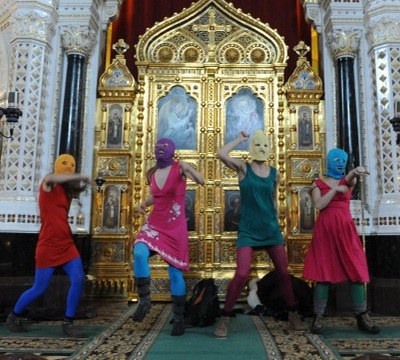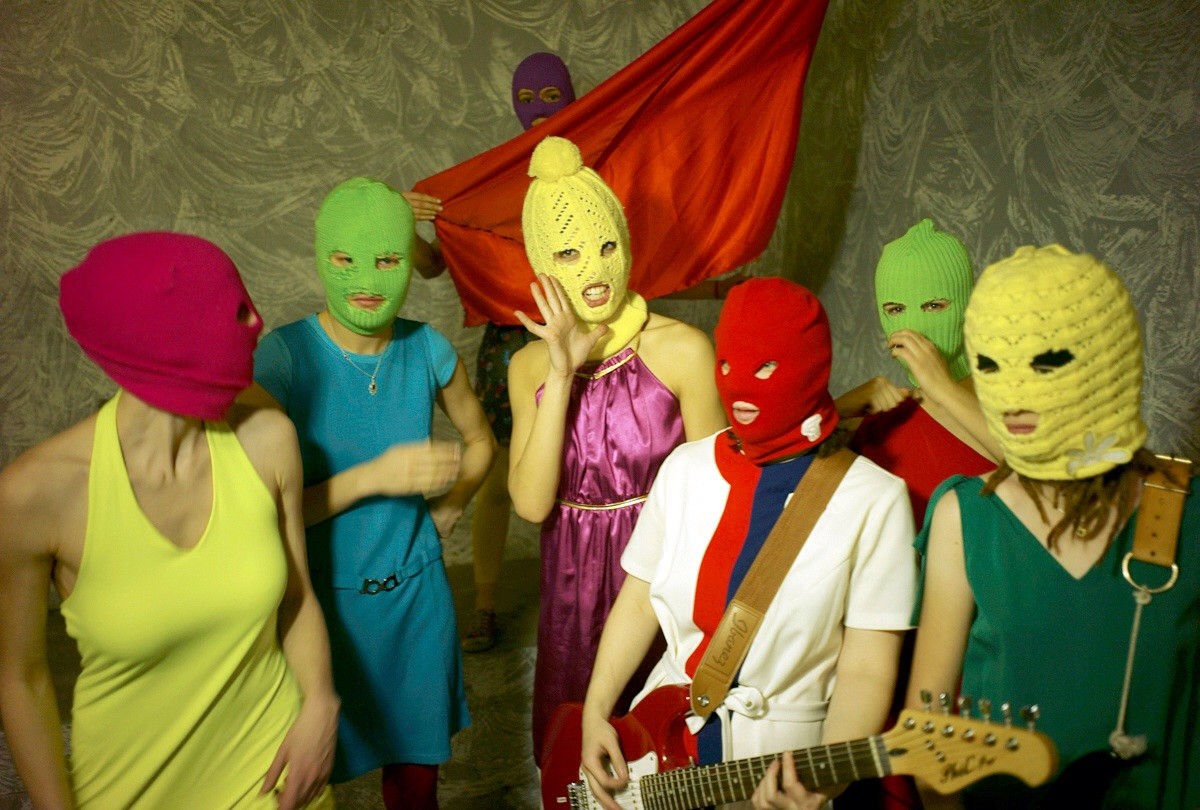Performing Philosophy: Masha Gessen’s Words Will Break Cement
Review by Alice E.M. Underwood
~
As an established voice speaking against Putin’s increasingly authoritarian actions, Russian journalist Masha Gessen emphasizes in her new book Words Will Break Cement: The Passion of Pussy Riot the ideological tension between culture and politics in the president’s attempt to reestablish Russia’s global power status. The book offers a biographical portrait of Nadya Tolokonnikova, Ekaterina Samusevich, and Maria Alyokhina, the three Pussy Riot members whose faces were hidden behind neon balaclavas during their punk performance in Moscow’s Cathedral of Christ the Savior, and who became familiar to the world during their subsequent trial. Gessen’s book was published at a turning point in Russia’s behavior on the world stage: weeks after Putin’s pardon of the two imprisoned Pussy Riot members, immediately prior to the Sochi Olympics, and against the backdrop of escalating tensions in Ukraine. Given Gessen’s record of critiquing Putinist repression of civil society, particularly surrounding questions of gender and sexuality, the book adds to the conversation on resistance to authoritarian regimes. Words Will Break Cement will likely appeal to a mixed audience: general readers curious about the formation and motivations of this guerrilla-style punk rock art collective, as well as scholars interested in unmasking the theory underlying Pussy Riot’s attempts to deconstruct both epistemological and political systems of power.
While the structure of Gessen’s portrait would benefit from tighter organization, her work is thorough in illustrating the philosophical development and political motives that brought the group together, and in explaining why those ideals got them arrested. The book is comprised of three sections: “Becoming Pussy Riot,” which pictures the lives of Pussy Riot’s three most prominent members prior to their emergence on the international stage; “Prayer and Response,” describing their infamous action in the Cathedral of Christ the Savior and its aftermath; and “Punishment,” which covers their post-trial lives. Each section interrogates the role of art and ideas in producing social change, and Gessen often cites her subjects citing theory. While her thesis regarding the intellectual foundation of Pussy Riot’s message might benefit from her own deeper engagement with the works that shape the punk rockers’ philosophy, she covers the impressive expanse of Pussy Riot’s library, which encompasses the Russian canon, queer theory, German existentialism, biblical scholarship, Soviet dissidence, and Moscow Conceptualism.
The frequency of Gessen’s references to these diverse intellectual camps demonstrates the significance she attributes to their role in Pussy Riot’s artistic philosophy. Meditations on the search for truth in face of a political system founded on hypocrisy and lies abound in the court statements, personal correspondences, and conversations among Pussy Riot members that Gessen reports. Their engagement of classical and contemporary philosophy contrasts the inflexible worldview characterizing the discourse of political realism and nationalism Putin uses to bolster Russia’s Great Power status. This “language of lies,” as Gessen puts it, has discredited “the language of confrontation itself” (35). Her corollary to this—“There were no words left”—suggests that donning bright balaclavas and dresses and screaming punk rock lyrics is the next step from such politically imposed aphasia.
Though not treating them extensively, Gessen finds in the traditions of dissidence and Conceptualism useful analogues for artistic movements that entail the disturbance of dominant epistemologies through aesthetic or performative practices, a key notion underlying Pussy Riot’s motives. The book’s first part, “Becoming Pussy Riot,” describes how Nadya Tolokonnikova, as a disenchanted philosophy student at Moscow State University, found meaning in Conceptualist art’s methods of “confronting the lie” (35) of public rhetoric. She joined the performance art collective Voina (War), which targeted consumerism and political corruption through performances in public spaces, and there encountered Kat, a computer programmer-turned-photographer. The two collaborated on several Voina actions, but soon became disenchanted with the misogynist tone taken in some of the group’s political performances (a conflict Gessen does not go into) and split to form their own group. There they were joined by Maria, an environmental activist studying at the Institute of Journalism and Literature, whose statement “We are forever serving life rather than living life” (qtd. 82) highlights the complacency—even complicity—within Russian society that the three united to combat.
Gessen’s account of Pussy Riot’s development and early actions demonstrates the importance of ethics and the quest for self-education that propelled each of the group’s members toward opposition through art, and ultimately toward each other. The background on these three—with an occasional mention of participants deemed more peripheral—gains critical dimension through Gessen’s focus on their goal of staging actions that would make political statements, but with such outlandish aesthetics that even the mainstream opposition movement wouldn’t know what to think.
This method was best—and most famously—exemplified by Pussy Riot’s Cathedral action, which targeted the collusion of Church and State and the superficiality of piety characterizing post-Soviet Russia. The site of their action, the Cathedral of Christ the Savior, was demolished during the Soviet period; since Yeltsin rebuilt it in the 1990s—one of his most popular moves, despite the tremendous cost at a time of economic depression—it has symbolized the renewed preeminence of Russian Orthodoxy. It has also become a site for politicians to perform piety and church dignitaries to benefit from ill-gotten political gains, however. Gessen is careful to justify Pussy Riot’s actions just as the group did: their aim was not to desecrate the church, but to show how it is “already being desecrated” (113) by the corruption of religious and political leaders.

Gessen builds suspense toward the infamous action in the Cathedral and Nadya, Kat, and Maria’s frantic work to produce the video clip of the performance that same evening. Her account of their collaboration, the initial media storm, and their subsequent experience of going into hiding provides behind-the-scenes insight about the group’s shifting dynamic as the three were propelled onto the world stage. Despite Gessen’s suspenseful account of the events leading to their arrest, it is curious that an argument whose focus is the art and words of Pussy Riot does not spend more time explaining the thinking behind the song that led to their incarceration. “Punk Prayer”’s paradoxical blend of punk rock and hymn is as jarring stylistically as lyrically. Of Pussy Riot’s songs, it is unique in highlighting the state’s violence and corruption without making an explicit call to action—with the exception of the direct pleas to Virgin Mary, Mother of God, to “chase Putin out” and to “become a feminist”—while other songs contain such provocative commands as “Kill the sexist,” “Fuck the leaders,” or at least, “Occupy the square, make the takeover peaceful.” One wonders why Gessen does not provide a closer reading of “Punk Prayer,” whose lyrics reveal careful composition emphasizing the Patriarch’s collusion with Putin as well as the human rights violations practiced by the regime and supported by the Church.
In the section about Pussy Riot’s trial—the book’s strongest part—Gessen compellingly stresses the surreal nature of the legislative process in post-Soviet Russia. Based on the charge of “hooliganism motivated by religious hatred,” the prosecution focused their case on Pussy Riot’s disrespect to the Russian Orthodox religion and consistently dodged the defendants’ attempts to explain their political motives. Gessen, who attended the trial, repeatedly likens the event to a poorly staged performance and to the show trials of dissidents under the Soviet regime. She portrays such political trials as following two typical trajectories: defendants attempt to fight for justice despite their awareness of the complete lack of due process, or they treat the trial as a farce and attempt to uncover its corrupt practices while making their own political point. Pussy Riot’s lawyers’ tactic of drawing attention to the trial’s legislative failings ended up “exacerbating the travesty” (185), in Gessen’s estimation, while Nadya, Maria, and Kat used the platform to deconstruct the logic of the charges (especially Kat and Maria, who became familiar with the penal code). Their ability to point to the absurdity of the system appealed to their international audience, if not to the civil servants within the Khamovnichesky Courthouse. Their closing statements, which Gessen reprints in full, provide poignant and useful insights for the reader. Nadya, citing historical cases of artists condemned for speaking against the regime, argues for “acting and living politically” (196) under the urge to always be seeking the truth. Maria condemns the Putinist power structure which teaches people to “live on autopilot” (211), unable to act or even think for themselves. Kat focuses on the space of the Cathedral itself as symbol of political strategy and aesthetic instrument for Putin’s consolidation of power, ending with the words, “We have won because the system cannot hide the repressive nature of this trial” (220).
It is a Pyrrhic victory, however: the women are sentenced to two years hard labor. Kat ends up having her sentence commuted to a suspension, while Maria carefully documents human rights violations in the penal colony and Nadya vacillates between similar lobbying, hunger strikes, and the desire to return to the comfort of philosophy. The author also describes her own visit to Nadya’s prison colony, and their reported conversation contains perhaps the clearest argument regarding Pussy Riot’s attempt to politicize the notion of “truth” by subverting state-controlled language through iconoclastic, if not incomprehensible, art forms. Gessen’s insertion into just the type of philosophical conversation that threads through the entire book underscores her thesis that Pussy Riot’s concept-driven political art has the potential to foster change because of its solid metaphysical foundation.
While Gessen impeccably illustrates the farce of the trials, the fear of the penal colonies, and the corruption and hypocrisy that characterize much of contemporary Russian society, one is left thinking that this book could have pushed further into larger questions of feminism and culture. Many Russians perceive feminism not as a movement for equity and understanding, but rather as a rabid extremism infecting women with the desire to kill men and unravel the very fabric of society—a claim that seems substantiated by a glance at Pussy Riot’s lyrics. Further, unconventional expressions of gender and sexuality are at the center of the movement, unorthodoxies that most Russians prefer not to confront. Both features represent the incursion of “Western” ideals of liberal democracy and civil rights that are all but anathema to Putin’s government and the propaganda machine that sustains it. Indeed, as Gessen notes in a recent op-ed titled “Russia is Remaking Itself as the Leader of the Anti-Western World,” Putin often lambasts such values as inherently anti-Russian: “The ‘so-called tolerance’ [Putin] mention[s] as the key feature of Western civilization is…nothing but a slide into immorality.”[i] Gessen’s book incisively contrasts that “so-called tolerance” to the Russian justice system, perhaps best summarized in Alyokhina’s closing statement: “For me, only this trial can rightly be referred to as ‘so-called’” (qtd. 216).
As a Russian journalist whose move to the US was at least in part politically motivated, Masha Gessen is well positioned to explain to her presumably mainly American audience some specifics of Russian culture that make the case of Pussy Riot so perplexing. Though she might have better clarified certain cultural disparities in Words Will Break Cement, overall she does succeed in painting a powerful picture of a Russia endangered by its monolithic condemnation of difference. Her account of Pussy Riot’s performance and prosecution exemplifies the role of state control over culture that has bolstered the nationalist and realist discourse Putin has used to justify his most recent moves to consolidate power. Under a system so cemented in ideology, one fears for the present and future potential of words—or even Conceptualist feminist punk rock—to break through.
_____
Alice E.M. Underwood is in the Ph.D. Program in the Comparative Literature Department at Stanford University. Her research addresses the intersections of poetics, sexuality, and political resistance in twentieth-century narrative prose, particularly in Russia and Latin America.
_____
Update, 29 May
Pussy Riot Meets Judith Butler and Rosi Braidotti
Organized and published by The First Supper Symposium: “creating spaces for female voices in the art world.”



Leave a Reply